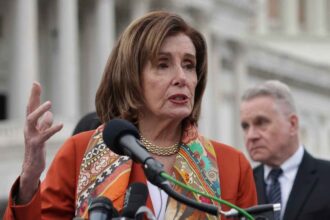- Trump’s proposed $2,000 “tariff dividend” would cost an estimated $600 billion annually.
- The projected expense doubles expected tariff revenue of $300 billion per year.
- Over ten years, the plan could expand federal deficits by $6 trillion.
- Legal challenges to Trump’s emergency tariff powers could block the proposal.
- Congressional approval would be required for any rebate checks.
President Donald Trump’s plan to send Americans $2,000 rebate checks funded by new tariffs could carry a staggering price tag of $600 billion a year, according to new projections by the Committee for a Responsible Federal Budget (CRFB). That figure is roughly twice the revenue the United States is expected to generate from the tariffs themselves.
The nonpartisan budget watchdog released its analysis on November 10, shortly after Trump floated the idea on Truth Social, claiming the U.S. was “taking in Trillions of Dollars” and promising that “a dividend of at least $2000 a person (not including high income people!) will be paid to everyone.”
Although the president did not outline specific eligibility criteria, the CRFB modeled its projections using the same framework as the COVID-19 stimulus payments from the 2020 CARES Act.
Those checks, distributed during Trump’s first term, provided direct payments to individuals earning up to $75,000 and joint filers earning up to $150,000, with additional funds for children.
Under those same parameters, the CRFB estimates that a single round of Trump’s proposed “tariff dividends” would total about $600 billion.
However, revenue from the administration’s new tariffs is expected to bring in only about $300 billion annually, half the cost. As of the end of October, those tariffs had generated roughly $100 billion in additional tax revenue.
Over a decade, the plan could add $6 trillion to the national deficit if distributed yearly, the group warned.
Speaking to reporters in the Oval Office on November 10, Trump reiterated his commitment to using tariff income to support working Americans. “We’re going to issue a dividend to our middle-income people and lower-income people about $2,000,” he said. “And we’ll use the remaining tariffs to lower our debt. We’re going to be lowering our debt, which is a national security thing.”
The president’s comments came amid heightened legal uncertainty surrounding his sweeping use of emergency powers to impose global tariffs. During recent Supreme Court arguments, several justices, both liberal and conservative appeared skeptical of the administration’s justification for invoking such powers.
Chief Justice John Roberts and Justices Neil Gorsuch and Amy Coney Barrett joined the court’s three liberal members in questioning whether Trump’s emergency declaration was lawful. If the court ultimately rules against the tariffs, the administration could be forced to refund billions to companies that paid the duties, potentially derailing Trump’s rebate plan altogether.
Congress would also need to approve any measure to redistribute tariff revenue as rebate checks, as it holds constitutional authority over federal spending.
A similar idea from Sen. Josh Hawley (R-Mo.), proposing $600 payments to eligible Americans funded by tariff income, failed to advance in committee earlier this year.
Trump previously hinted at other ways to share government savings with citizens, including a proposal to issue checks based on cost-cutting measures led by Elon Musk’s Department of Government Efficiency, or DOGE. That plan, too, has yet to materialize.








